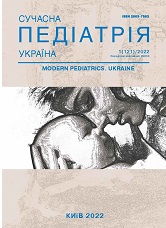Features of treatment of children with epithelial coccygeal course, which enable to obtain a satisfactory result
DOI:
https://doi.org/10.15574/SP.2022.121.55Keywords:
epithelial coccygeal course, children, treatmentAbstract
For 10 years (2010-2020) 46 children with epithelial coccygeal course were treated. 40 (87%) had coccygeal cysts with coccygeal fistula, 6 (13%) had no fistula. The number of boys prevailed - 32 (67%), girls - 14 (33%), which corresponds to the literature. By age, patients were distributed: up to 10 years - 6 (13%) patients, 10-14 years - 8 (17%), from 14 years - 32 (70%) patients.
The number of purulent complications during this period has halved (from 12% to 6%). Since the nature of the applied surgical interventions during this time has not changed significantly, the positive result, according to the authors, was achieved due to the improvement of old and introduction of new methods of pre- and post-operative periods. The detailed analysis of preoperative preparation is carried out in the work, some stages of operative intervention are reflected, the rules of conducting the postoperative period are detailed.
Emphasis is placed on the importance of the following methods of treatment of children with epithelial coccygeal course.
Before surgery: fistulography as an extremely important method of diagnosis; the use of hypoallergenic depilatory creams to prepare the operating field.
Surgery: performing and completing the operation without ligatures in the surgical wound due to careful hemostasis, which prevents the occurrence of ligature fistulas in the postoperative period.
After surgery: a ban on sitting for two weeks and following the rules of asepsis in the area of the surgical wound provides, as a rule, primary healing.
Fulfillment of these features in the treatment of children with epithelial coccygeal course allows to obtain a satisfactory end result.
The research was carried out in accordance with the principles of the Helsinki declaration. The informed consent of the patient was obtained for conducting the studies.
No conflict of interests was declared by the authors.
References
Halleran DR, Onwuka AJ, Lawrence AE, Fischer BC, Deans KJ, Minneci PC. (2018). Laser Hair Depilation in the Treatment of Pilonidal Disease: A Systematic Review. Surg Infect (Larchmt). 19 (6): 566-572. https://doi.org/10.1089/sur.2018.099; PMid:30095368
Kalaiselvan R, Bathla S, Allen W, Liyanage A, Rajaganeshan R. (2019). Minimally invasive techniques in the management of pilonidal disease. Int J Colorectal Dis. 34 (4): 561-568. https://doi.org/10.1007/s00384-019-03260-y; PMid:30810799
Manigrasso M, Velotti N, Sosa Fernandez LM, Vertaldi S, Maione F, Gennarelli N, Dinuzzi VP, Musella M, De Palma GD, Milone M. (2021). Endoscopic Approach to Recurrent Pilonidal Sinus: A Retrospective Analysis. J Laparoendosc Adv Surg Tech A. 31 (1): 1-5. https://doi.org/10.1089/lap.2020.0252; PMid:32678724
Metzger GA, Apfeld JC, Nishimura L, Beyene TJ, Lutz C, Deans KJ, Minneci PC. (2021). Room for Improvement: The Trephination Procedure for Pediatric Patients with Pilonidal Disease. J Surg Res. 12 (267): 605-611. https://doi.org/10.1016/j.jss.2021.06.010; PMid:34271267
Metzger GA, Apfeld JC, Nishimura L, Lutz C, Deans KJ, Minneci PC. (2021). Principles in treating pediatric patients with pilonidal disease - An expert perspective. Ann Med Surg (Lond). 27 (64): 102233. https://doi.org/10.1016/j.amsu.2021.102233; PMid:33868675 PMCid:PMC8040102
Milone M, Basso L, Manigrasso M, Pietroletti R, Bondurri A, La Torre M, Milito G, Pozzo M, Segre D, Perinotti R, Gallo G. (2021). Consensus statement of the Italian society of colorectal surgery (SICCR): management and treatment of pilonidal disease. Tech Coloproctol. 25 (12):1269-1280. https://doi.org/10.1007/s10151-021-02487-8; PMid:34176001 PMCid:PMC8580911
Milone M, Velotti N, Manigrasso M, Milone F, Sosa Fernandez LM, De Palma GD. (2019). Video-assisted ablation of pilonidal sinus (VAAPS) versus sinusectomy for treatment of chronic pilonidal sinus disease: a comparative study. Updates Surg. 71 (1):179-183. https://doi.org/10.1007/s13304-018-00611-2; PMid:30542957
Prieto JM, Checchi KD, Kling KM, Ignacio RC, Bickler SW, Saenz NC, Fairbanks TJ, Nicholson SI, Lazar DA. (2020). Trephination versus wide excision for the treatment of pediatric pilonidal disease. J Pediatr Surg. 55 (4): 747-751. https://doi.org/10.1016/j.jpedsurg.2019.06.014; PMid:31301885
Shavliuk R, Konoplitskiy V. (2020). Pilonidal disease in children: some links of etiopathogenesis of the disease (clinical observation). Pediatric Surgery. Ukraine. 2 (67): 85-90. https://doi.org/10.15574/PS.2020.67.85
Downloads
Published
Issue
Section
License
Copyright (c) 2022 Modern pediatrics. Ukraine

This work is licensed under a Creative Commons Attribution-NonCommercial 4.0 International License.
The policy of the Journal “MODERN PEDIATRICS. UKRAINE” is compatible with the vast majority of funders' of open access and self-archiving policies. The journal provides immediate open access route being convinced that everyone – not only scientists - can benefit from research results, and publishes articles exclusively under open access distribution, with a Creative Commons Attribution-Noncommercial 4.0 international license (СС BY-NC).
Authors transfer the copyright to the Journal “MODERN PEDIATRICS. UKRAINE” when the manuscript is accepted for publication. Authors declare that this manuscript has not been published nor is under simultaneous consideration for publication elsewhere. After publication, the articles become freely available on-line to the public.
Readers have the right to use, distribute, and reproduce articles in any medium, provided the articles and the journal are properly cited.
The use of published materials for commercial purposes is strongly prohibited.

